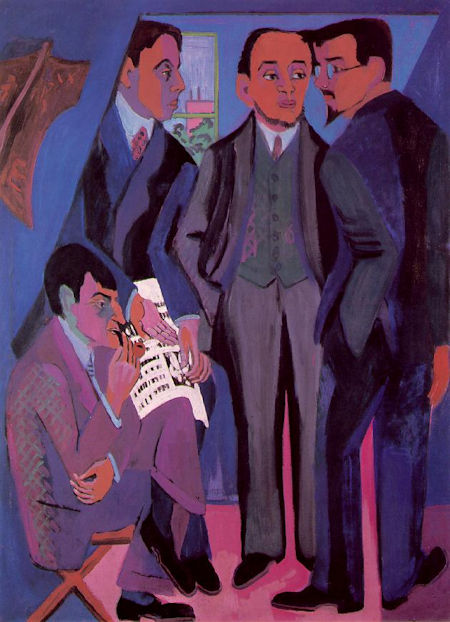


EXPRESSIONISM
Outline History
Expressionism is not a movement in the sense that Impressionism was. It is more a quality, a way of painting, used by artists to reinforce a idea and usually based on distortion of form (objects, people and places). Movements based on social torment or political protest often use Expressionism as a means of emphasising or dramatising their ideas. The pictorial qualities of Expressionism usually includes one or more of the following:
• Distortion caused by the overriding emotional tensions in the painting – e.g. dramatic interactions between people
• Distortion based on the graphic and colourful potential of the medium (woodcut, oil paint, water colour) – e.g. using extreme colour schemes
• Distortion taking its queue from vernacular or primitive art – e.g. children’s drawing, tribal art etc
• Distortion based on the French cubist techniques of faceting, or the breaking up of image using geometrical structures – e.g. early Picasso paintings
Expressionism is an art form usually associated with Northern Europe – Germany and Scandinavia. It can be traced back to the work of Dürer, Grünewald and Bosch, however, it reached its height in the late 19th and early 20th centuries. Generally, it can be split into three phases:
• 1885 – 1900 The fore-runners, artists such as Vincent Van Gogh, James Ensor, Edvard Munch and Paul Gauguin reacted against the painting of what is perceived by artists such as Paul Cézanne and Georges Seurat.
• 1900 – 1912 Picasso in his Blue and Rose periods and the Fauve movement in France. The political stresses of unification in Germany influenced and led to such groups as Die Brücke (see below).
• 1910 – 1930 The height of German and Viennese Expressionism including such groups as Der Blaue Reiter, and early Kandinsky
Die Brücke 1905 – 1913
Die Brücke (The Bridge) was a movement of social and psychological protest. Like the Fauves, it accepted the autonomy of the work of art as being based on the construction of a parallel world to nature. Not merely a description of it. Yet, the most important subject of expressionist painting was often the human figure.
Ernst Ludwig Kirchner was the leader of Die Brücke. He was born in 1880 the son of a paper factory director. He studied architecture in Dresden where he met Bleyl and Heckel who would become fellow members. Their paintings were based on everyday surroundings, street scenes, portraits and their own studios. Their work was filled with life and their own experiences. ‘The entirely naïve and unadulterated need to bring art and life into unity,’ Kirchner.
When the group moved to Berlin in 1911 the truly expressionist character of the painting of Die Brücke was revealed. Kirchner and Heckel’s work assumed an angular, spiky quality and colour was muted. A new visual language evolved, in painting as well as woodcuts. This new visual language’s quality was barbarism, the result of trying to depict the sordid side of city life.
‘I undertook the withdrawal of self from itself and its dissolution within the other person’s psyche for the sake of a more intense expression,’ Kirchner.
Check out my YouTube Channel
for great How to Draw tutorials designed for children
